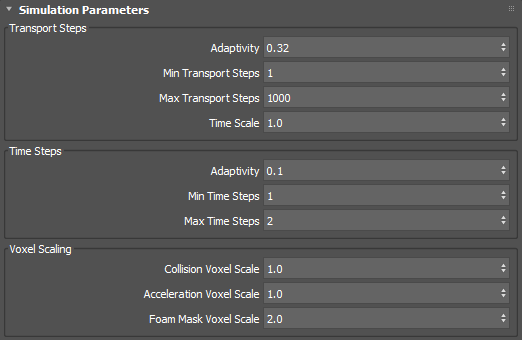General Parameters rollout

Frame Range group
- Use Timeline
- Uses the current timeline to set the frame range for the simulation.
- Start Frame
- Sets the start frame for the simulation.
- End Frame
- Sets the end frame of the simulation.
Scale group
- Use System Scale
- Sets the simulation to use the system scale, which can be changed in the Customize menu under Unit Setup.
- Fluid Scale
- Overrides the system scale and uses a custom one using the specified units. This is useful for making simulations look more realistic when a model's scale does not equal the desired real-world scale. For example, if a model of a submarine was originally scaled as ten feet long but you want to make the simulation react as if the vessel was a hundred feet long, you can adjust the fluid scale by ten times, making one unit equal 12 inches instead of 1.0.
- Auto-rescale Parameters
- Automatically rescales the base voxel size to use the custom fluid scale. If disabled, the base voxel size is not scaled accordingly and parameters will no longer match.
Solver Properties group
- Base Voxel Size
- Sets the base resolution for the simulation in grid units. Lower values produce greater detail and accuracy but require more memory and computation. Higher values are useful for getting a quick preview of the simulation's behavior or when working on a system with limited memory and processing power.
- Gravity Magnitude
- The acceleration strength of gravity as expressed in meters per second squared by default. A value of 9.8 corresponds to the Earth's gravity while a value of 0 simulates a zero gravity environment.
- Create Gravity Force
- Creates a Gravity Helper object in the scene. The orientation of the arrow will adjust the direction of the gravity.
- Use Gravity Node Strength
- When enabled, uses the strength of the Gravity Helper object in the scene instead of the Gravity Magnitude.
- Spacial Adaptivity
- In liquid simulations, allows for lower-resolution voxels in the center of the fluid where detail is usually not needed. This can avoid unnecessary computation and help system performance.
- Delete Exceeding Particles
- Removes particles when the number per voxel in low-resolution regions exceeds a certain threshold. Turn this option off when there is volume loss or other large differences between spatially-adaptive and non-adaptive simulations.
Simulation Parameters rollout

Transport Steps group
- Adaptivity
- Controls the number of iterations used to advect the particles along the voxel velocity field, after the pressure calculations have been performed. Lower values will be less likely to trigger further substeps.
Be careful not to increase this setting too much at once, particularly for values close to 1.0. Doing so may cause unnecessarily long computations. Also note that distances are measured in voxel lengths, which means a lower base voxel size may trigger extra iterations for particles at a given velocity.
- Min Transport Steps
- Sets the minimum number of transport iterations.
- Max Transport Steps
- Sets the maximum number of transport iterations.
- Timescale
- Changes the speed of the particle flow. Values greater than 1.0 speed up the flow without introducing any new velocities or accelerations, while values between 0.0 and 1.0 slow it down.
Time Steps group
- Adaptivity
- Controls the number of iterations of the whole simulation per frame, including the voxelization, pressure, and transport phases. Lower values will be less likely to trigger further substeps.
Caution: Be careful not to increase this setting too much at once, particularly for values close to 1.0. Doing so may cause unnecessarily long computations. Also note that distances are measured in voxel lengths, which means a lower base voxel size may trigger extra iterations for particles at a given velocity.
- Min Time Steps
- Sets the minimum number of time step iterations.
- Max Time Steps
- Sets the maximum number of time step iterations.
Voxel Scaling group
- Collision Voxel Scale
- A multiplier for the base voxel size used for voxelizing all collision objects.
- Acceleration Voxel Scale
- A multiplier for the base voxel size used for voxelizing all accelerator objects.
- Foam Mask Voxel Scale
- A multiplier for the base voxel size used for voxelizing all foam masks.
